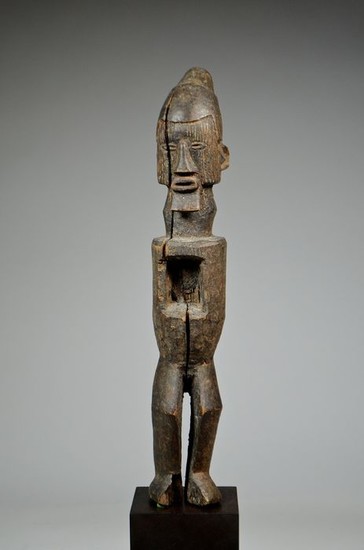Power figure - Wood - Butti - TEKE - Democratic Republic of Congo
Among the major art forms of the Teke peoples of the Republic of the Congo are wood figures with medicines. The medicines are attached to the trunk and embedded in an abdominal cavity carved for that purpose. The museum's example, a standing male wood figure, displays bilateral symmetry. The ovoid head, sitting squarely on the neck, has horizontal slit eyes; a small, rectangular mouth; a triangular nose; small, protruding, hemispherical ears; a trapezoidal beard; and a cylindrical coiffure. This hairstyle, called imwu, is worn by the elite or descendants of noble families. The face has deeply carved, evenly spaced vertical lines representing typical Teke scarification (mbandjuala) . The deeply undercut legs emphasize the angularity of the knees, hips, ankles and feet. Individually owned, they represented and were named after a deceased male ancestor or chief. A butti was kept in its male owner's house, and when he died, it was buried with him. A more recent study suggests that these figures were used in various ritual contexts. Shipping via Royal Mail (unless requested otherwise) within 24hrs after payment is received. Tracking number will be provided. Signature upon delivery. Fully insured.
[ translate ]View it on
Sale price
Estimate
Time, Location
Auction House
Among the major art forms of the Teke peoples of the Republic of the Congo are wood figures with medicines. The medicines are attached to the trunk and embedded in an abdominal cavity carved for that purpose. The museum's example, a standing male wood figure, displays bilateral symmetry. The ovoid head, sitting squarely on the neck, has horizontal slit eyes; a small, rectangular mouth; a triangular nose; small, protruding, hemispherical ears; a trapezoidal beard; and a cylindrical coiffure. This hairstyle, called imwu, is worn by the elite or descendants of noble families. The face has deeply carved, evenly spaced vertical lines representing typical Teke scarification (mbandjuala) . The deeply undercut legs emphasize the angularity of the knees, hips, ankles and feet. Individually owned, they represented and were named after a deceased male ancestor or chief. A butti was kept in its male owner's house, and when he died, it was buried with him. A more recent study suggests that these figures were used in various ritual contexts. Shipping via Royal Mail (unless requested otherwise) within 24hrs after payment is received. Tracking number will be provided. Signature upon delivery. Fully insured.
[ translate ]


